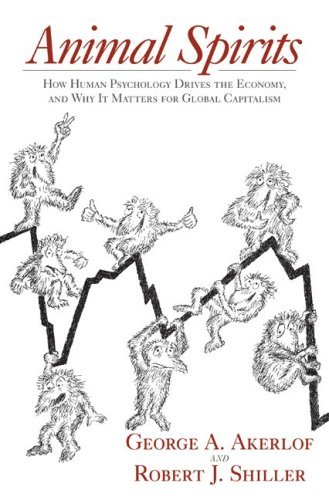Reviewed by
Andreas Ernst
Center for Environmental Systems Research, University of Kassel
 The comic on the book cover shows a horde of funny apes climbing up and sliding down a stock price curve, excited when it goes up, being horrified when going down, being depressed in the valleys, cheering on the tops. The animal spirits are riding and driving the ups and downs of economy - that is the message of the book in a nutshell.
The comic on the book cover shows a horde of funny apes climbing up and sliding down a stock price curve, excited when it goes up, being horrified when going down, being depressed in the valleys, cheering on the tops. The animal spirits are riding and driving the ups and downs of economy - that is the message of the book in a nutshell. Being a psychologist with some understanding of the struggle of economics between beauty and elegance of a dominant theory and a never ending stream of empirical anomalies, I was wondering in how far such a book could inform us (modelers) about the workings of those animal spirits. What are the phenomena that can be better explained in psych terms, and what are the processes that drive them? It is useful to know that the authors are highly distinguished people: the one (Akerlof) a Nobel prize laureate, the other (Shiller) creator of the Standard & Poor's/Case-Shiller Home Price Index and best-selling textbook author. Furthermore, this very book seems to be one of the "must-reads" in the Obama administration.
The authors identify five cognitive and social psychological core phenomena as the "animal spirits" (a term coined by Keynes): Confidence, corruption, money illusion, fairness, and stories. While this list by itself does not seem to impress much, it is the way the working of these psychological mechanisms is knitted into the economic fabric. This is explained in detail and very convincingly in the book, driven by a number of questions that have proven tricky for classical economic theory. Among these are: Why do economies fall into depression? Why are there people who cannot find a job? Why are financial prices and corporate investments so volatile? Why is there special poverty among minorities?
Confidence is shown to be the basis of economic behavior. It is the expectation of a positive development in the future. That is also where phenomena of social amplification come into play. There are times where confidence can abound and, with no reliable basis, go beyond the rational. These are usually hype times, where a second factor comes in: corruption and bad faith. There are incentives to profit from the trustful people that are overly enthusiastic from the hype and believe in an everlasting growth. People are, concerning large parts of the economy, unaware of what is good or bad for them, and there are cases where they are intentionally misinformed about what they buy (this is snake-oil, supposed to cure everything, but actually ineffective). This is exactly what happened with the re-packaged subprime mortgages. The authors analyze the cases of the last three big recessions in the United States, where each time corruption played a major role in ending the economic growth. This explains how positive developments are being perverted and stopped.
Money illusion is the cognitive failure to account for inflation or deflation in prices or wages. Nominal sums of money thus seem to matter much too much to us. This is the origin for, e.g., the unions resisting to cuts in pay or even to ask for raises in pay in times of recession and price decline. As a consequence, wage contracts are not indexed for economic variability, or, if so, only in one direction, i.e., growth. This might, according to the authors, add to the problems in a recession. Furthermore, wages are seen to be fair only when they are slightly above the market clearing wage. That is why we find (involuntary) unemployment.
People want to make sense of what they see, even if or especially if their understanding is not dictated by evidence. Here social psychology comes in: People start telling each other stories, and the story that "wins" is not necessarily the one that comes closest to reality. Each economic bubble has such a story of success, of a quasi-infinite growth of some economic sector. This social amplification process is identified as the core of the irrational exuberance of economic hypes. Another important story relates to spending someone's money: It is good and normal to consume, it is good and normal to use your credit card, and it is much less comprehensible to bring your money to a savings account (the US currently have a negative savings rate).
As a conclusion, Akerlof and Shiller would like no less than to replace the fallen economy, i.e., devise a new system of stronger supervision and install new mechanisms which take into account the power of animal spirits and thus protect people from being fooled by others offering them snake oil, from false beliefs, or exaggerated stories.
The authors make the point that and where animal spirits matter, but do not give many hints to how they do. The first might be a matter of course to most of us, and only the second would have been helpful to modelers. So this remains a book for the yet-to-be-convinced hard core neo-classical addict to be converted, for the more enlightened economist to be confirmed in her views, or for the rest of us that just like to be given an insightful and competent catalogue of social phenomena that drive the economy.
Return to Contents
of this issue
© Copyright Journal of Artificial Societies and Social Simulation, 2009